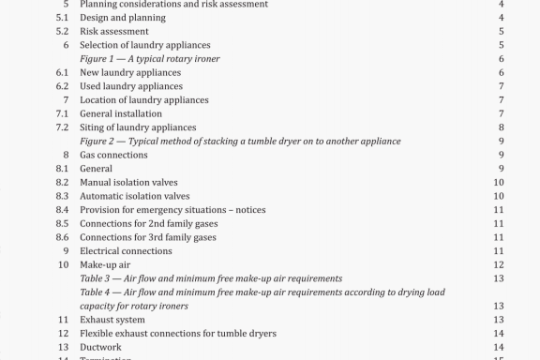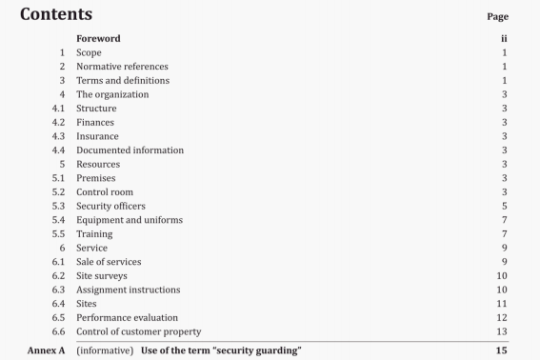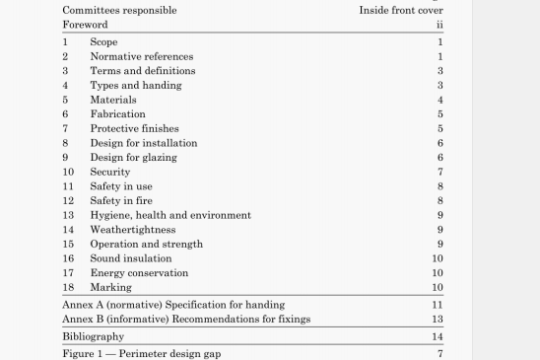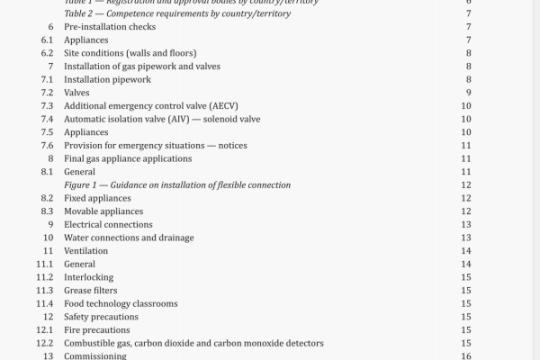BS 6891:2005 pdf download
BS 6891:2005 pdf download.Installation of low pressure gas pipe work of up to 35 mm (R11/4) indomestic premises(2nd family gas)——Specification.
5 Design and planning
5.1 Exchange of information and time schedule
5.1.1 At the initial stages of building design and planning the designerlinstaller shall verify that the installation pipes will bc adequate for both immediate and probable future requirements. A tinw schedule for fixing the installation pipes shall be agreed as early as possible and any subsequent change notified to interested parties at the earliest opportunity.
5.1.2 All ii cesary information regarding the routing of installation pipes and positions of valves and termination points to serve the appliances shall be made available to those concerned as early as possible 1w means of drawings, specifications and consultations, as appropriate.
Any drawings should also include:
a) the position of coids. shafts, duels, and channels when installatwn pipes are to be concealed:
c) sizes, and materials and position of all installation pipes and fittings.
5.1.3 Any installation pipe fitted as construction of a building progresses, and which will subsequently be inaccessible, shall be tested for gas tightness in accordance with Clause 10 before being buried, covered or wrapped.
5.1.4 Any work to be done by the gas installer and which could be damaged or impaired by other trades shall be clearly identified.
5.2 Pipe sizing
5.2.1 When designing an installation, the sizes of all installation pipes shall be determined from the maximum gas rate of the appliances to be connected.
Allowance should also be made for any future exiensions which might be anticipated, especially if the pipes are to be buried. Annex A glees a method of cokulating pipe sizes in a system.
5.2.2 The pressure drop between the outlet of the meter and the points to be connected shall not exceed I mbar at. maximum flow conditions (see Table 1).
8.5.2 Polyethylene pipe and fittings shall only be used above grotrnd to extend underground polyethylene installation pipe above ground level for entry into a building. The polyethylene pipework above ground level shall rise vertically to the point of entry into the building, which shall be as close as practicable to the external ground level. The length of pipework above ground level shall be protected against daylight and mechanical damage.
8.5.3 Solvent welding shall not be used.
8.5.4 Fusion or electrofusion welding shall be carried out only by persons trained and competent to do so.
Advice shall be sought from the pipe manufacturer.
COMMENTARY AND RECOMMENI1ATIONS ON 8.5
The use of polyethylene installation pipework and fittings may be beneficial where it is necesiia,y for inslallation pipework to be run underground externally from one location to another.
It is essential that care he taken to ensure that pipes designed for carrying water are not used for gas installations. Also, plastics pipes designed to distribute water in both domestic hot/cold water and central heating gystems. whether or not they contain a metallic barrier. are not suitable for use for gas installations
8.6 Connection and disconnection of pipes and fittings
Where any installation pipe is no longer required, the pipe(s) shall be disconnected as close to the point of supply as practicable. All pipe ends shall be sealed with an appropriate fitting, e.g. a plug or cap.
During any work that necessitates connection or disconnection of any metal installation pipework, a temporary continuity bond shall be fixed where production of a spark or shock could cause a hazard. whether or not permanent equipotential bonding has been established (see Figure
Where prucskabk, any redundant pipework should be removed.
The recommended disconnection procedure is as follows.
a) Isolate the electrical connection of associated gas appliances from the elect ricitv mains supply.
b) Clip or clamp a temporary continuity bond to each side of the union, fittings or compkte section that is to be removed or connected ensuring that good metallic contact is made (see Figure 3).
c) Leave the bond in position until after the work is completed and metallic continuity re-established.




